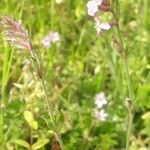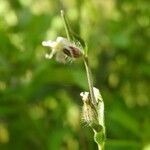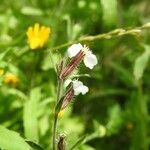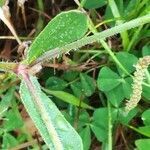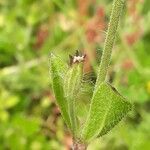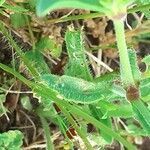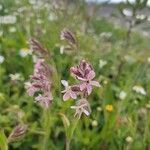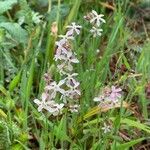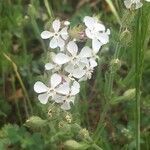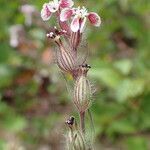Plants annual; taproot slender. Stems erect, branched, rarely simple, 15-45 cm, with long, often crinkled hairs mixed with short pubescence, viscid-glandular distally. Leaves 2 per node, blade with coarse, ascending, scabrous pubescence on both surfaces; basal few, withering, blade oblanceolate to spatulate-petiolate, 0.5-5 cm × 3-15 mm; cauline blades oblanceolate to lanceolate, 1-7 cm × 1-15 mm, apex obtuse or shortly acuminate to acute. Inflorescences open, with racemose branches, internodes and bracts usually ca. equaling fruiting calyx, 1-5 mm, longer proximally. Flowers 5-8 mm diam.; calyx prominently 10-veined, narrowly tubular-ovoid in flower, ovoid in fruit, constricted at mouth, 7-10 × 3-5 mm, membranous between veins, margins dentate, hispid, hairs ca. 2 mm, veins parallel, lobes lanceolate, 2-2.5 mm, apex greenish purple, acute; petals white or pink, often with dark spot or dark pink throughout, clawed, claw equaling calyx, limb elliptic to obovate, lobed or unlobed, to 6 mm, appendages 2, oblong to narrowly lanceolate, 1-1.5 mm; stamens equaling or shorter than calyx; stigmas 3, included in calyx. Capsules equaling calyx, opening with 6 recurved, narrowly triangular teeth; carpophore shorter than 1 mm, pubescent. Seeds dark reddish brown, reniform, angular with concave, radially ridged faces, broad outer edge transversely ridged and verrucose, ca. 0.5 mm broad. 2n = 24.
Taprooted annual. Stems simple or branching, (3)-15-45 cm tall; hairs long and eglandular below becoming mixed with sparse to dense short eglandular hairs above. Lvs hispid, with shorter hairs on margins, green, oblong to oblanceolate, subacute to obtuse; lower lvs cuneately tapered to petiole, 20-60 × 5-15 mm; upper lvs sessile, becoming lanceolate, acute, smaller. Infl. usually a single (1)-5-15-flowered spike-like monochasium, rarely of paired monochasia and then without a fl. in the axil between them, elongating at fruiting; pedicels 2-10 mm long; bracts linear, acute, green. Fls ☿. Calyx with dense short glandular hairs and sparse long eglandular hairs, cylindric at flowering, ovoid at fruiting, 10-veined, 7-10 mm long; teeth linear, erect. Petals white, pink or red or red-spotted, entire or emarginate; claw not lobed; coronal scales oblong, subacute, 1.5 mm long. Styles 3, erect, 2 mm long. Capsule ovoid, c. = calyx, 7-10 mm long, dehiscing by 6 curved teeth; carpophore c. 0.5 mm long. Seeds dark brown, reniform with hollow faces and flat backs, ridged, c. 0.8 mm long.
Herbs, annual, pubescent, glandular above. Stems erect, simple to much-branched, 15–45 cm high. Leaves hispid-pilose, subobtuse, 10–35 mm long, 1–10 mm wide; lower leaves with petioles to 10 mm long, oblong-spathulate; upper leaves sessile, lanceolate. Inflorescence simple, racemose, 1–several-flowered; bracts herbaceous. Pedicels all erect in fruit; lower pedicels to 1.5 times calyx length; upper pedicels shorter. Calyx cylindrical-ovoid, 7–10 mm long, erect and accrescent in fruit, 10-veined, glandular-pubescent, pilose on the veins; calyx lobes ¼ of calyx length, narrow-triangular to linear-lanceolate, acute. Petal limb to 5 mm long, white or pink, with or without dark crimson basal spot, entire to emarginate. Styles 3. Capsule ovoid, 6–9 mm long, opening by 6 spreading teeth; carpophore 0.5–2 mm long, ± puberulent. Seeds reniform, 0.8–1.2 mm long, dark greyish brown; faces deeply concave, bluntly tuberculate; dorsal edge of seed flat to ± grooved, but not winged.
An annual herb with simple or branched stems, 1.4–4.0 dm. tall, with spreading hairs, some very short others up to 2 mm. in length.. Leaves oblanceolate or spathulate-oblanceolate, generally rounded and mucronulate at the apex, narrowed to the base, up to 7.7 cm. long and 2.2 cm. broad.. Inflorescence with the appearance of a one-sided raceme terminating the stem or its branches, elongating with age, 2–9-flowered.. Calyx 8–10 mm. long, enlarging (and especially broadening) in fruit.. Petals entire, 9–11 mm. long and with the expanded portion 1.5–3.5 mm. broad, white or pinkish.. Capsules on stalks 2–10 mm. long, erect to more or less reflexed.. Seeds small, grey to black, minutely tubercled to flat-plated (“armadillo”).
Annual 1–4 dm, conspicuously hirsute (or the lvs merely puberulent), and glandular above; basal lvs few, oblanceolate to spatulate, the cauline narrower, 1.5–4 cm × 2–8(–15) mm; fls ± erect, in a leafy-bracteate, raceme-like, secund monochasial cyme; cal 6–9 mm and tubular at anthesis, later inflated but scarcely accrescent, 10-nerved, glandular and hairy; pet white to pink, slightly longer than the cal, entire or sometimes slightly toothed, the appendages linear and entire; carpophore to 1 mm; fr 3-locular except at the tip; seeds 1 mm wide, finely corrugate-rugose; 2n=24. Native of Eurasia, occasionally intr. in our range. Apr–July. (S. quinquevulnera, with a crimson spot on the pet; S. anglica, misapplied)
Polymorphous annual. Stem erect, up to 40 cm, simple or branched, pubescent, viscid in upper part, rarely glabrous. Leaves narrowly obovate-elliptic to spathulate, pubescent. Flowers in one to several monochasial cymes with the appearance of a one-sided raceme. Calyx cylindrical to ovoid, hispid, 8-10 mm, elongating in fruit, divided into 1/4, teeth triangular, acute. Petals white or pink, often with dark red spot or dark veins, lamina entire or emarginate, 3-5 mm. Capsule ovoid, 5-10 mm; carpophore 1 mm. Seeds reniform, grey, brown or black, faces deeply concave, striate or minutely tubercled, c. 1 mm.
Inflorescences of terminal cymes, often with the flowers on one side of the rhachis, elongating in fruit, 2–9-flowered; bracts foliaceous, narrowly lanceolate, sessile, hairy with the hairs often glandular, smaller than the leaves and decreasing in size up the rhachis; pedicels 0–c. 8 mm. long, hairy.
Annual herb, up to 0.45 m high. Stems sticky hairy. Leaves opposite, sessile; narrowly ovate. Flowers: in a spike-like inflorescence, mostly pointing in one direction; calyx 10-12 mm long; petals notched, white or pink or with a deep red mark (var. quinquevulnera).
Glandular-hairy, ± sticky annual, up to 450 mm tall. Leaves oblanceolate, ciliate. Flowers in ± one-sided, spike-like monochasial cymes, white or pink, calyx coarsely hairy, 7-10 mm long, petals entire, carpophore ± 1 mm long. Calyx contracted at mouth in fruit.
Glandular-hairy annual, up to 0.45 m high. Leaves oblanceolate, ciliate. Flowers in subsecund, spike-like, monochasial cymes, white or pink; calyx coarsely hairy, 7-10 mm long; petals entire; carpophore ± 1 mm long. Flowering time Sept.-Feb.
Leaves up to 8 × 2·5 cm., sessile or the basal ones narrowing into a short petiole, oblanceolate to spathulate-oblanceolate, rounded or obtuse and mucronate at the apex, cuneate at the base, sparsely hairy on both sides.
Glandular-hairy annual to 45 cm. Leaves oblanceolate, ciliate. Flowers in subsecund, spike-like, monochasial cymes, white or pink, calyx bristly, 7-10 mm long, petals entire, carpophore ± 1 mm long.
Calyx c. 8 × 2 mm., oblong-cylindric, enlarging and becoming broadly campanulate in fruit, with both long simple hairs and glandular hairs, 10-veined, with 5 acuminate teeth c. 2 mm. long.
Annual herb with simple or branching stems up to 40 cm. tall; internodes often purplish, with some very short hairs and others up to 2 mm. long.
Petals white or pinkish, 0·9–1·1 cm. long, narrowly oblanceolate with a long claw and entire limb, with 2 acute coronal scales c. 1·5 mm. long.
Seeds numerous, dark brown or blackish, c. 0·8 mm. in diam., reniform with depressed faces, minutely tubercled to flat-plated (“armadillo”).
Ovary narrowly ovoid on a very short puberulous stalk; styles 3, c. 2·5 mm. long, hairy.
Capsule ovoid, about as long as the persistent calyx; stalk c. 1 mm. long.
Stamens with hairy filaments ± the length of the petal-claw.
